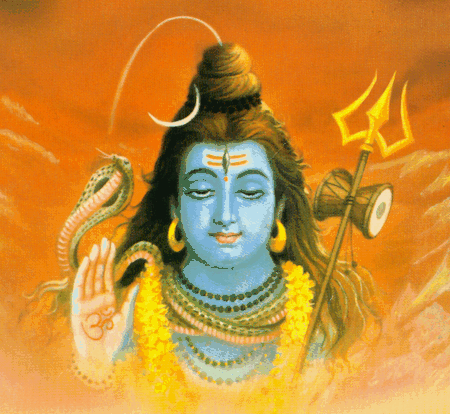THE RUDRAM
 PRESENTATION BY
J.B.BHATT
RAMA VENKATARAMAN
AND
ALAMELU RAMAKRISHNAN
INTRODUCTION
PRESENTATION BY
J.B.BHATT
RAMA VENKATARAMAN
AND
ALAMELU RAMAKRISHNAN
INTRODUCTION
The
Rudram-Chamakam figures in the
4th. of the 6 Kandas
of the Taittiriya Samhita of
the Yajur Veda. It is
also called the Satarudriyam
because versions of it
are to be found in the
more than 100 Sakas of the
Yajur and other Vedas. At
it's core is to be found the
Panchakshara Mantra -
nm¢Svay
- the five-lettered
Mantra considered among the
holiest of Mantras. The
Rudram is so central
to religious belief that
it figures in all important
religious rites. It has a higher
philosophical import
of leading
to liberation and is therefore also
referred as the Rudropanishad, and is
recommended for everyday recitation.
The
Rudram is addressed to worship
of the Lord Siva, who
is said to give to
the devotee who seeks His
Grace anything that is asked
for, from the worldly to
the other worldly. The Rudram
occurs in two sloka sequences,
the first called the Namakam
and the second, the Chamakam.
The Namakam, is so
called because each of
its slokas ends with the
word
nm:
to signify the
devotee's offering. These slokas
are spread over 11
Chapters or Anuvakas The
Chamakam is so called because each
of it's slokas
ends with the words
c mE
, to a
devotee asking for himself
all the things he
could possibly want. A
higher philosophical
implication is
that the devotee can
get whatever he may
desire by recognising his
essential identity with everything that he
sees as separate
from himself..
The Chamakam is also composed
of 11 Anuvakas.
Recitation
of the Rudram-Chamakam is
prescibed at massive levels
of repetition according to a
specific pattern. The first
is the ordinary level
where the 11 Anuvakas
of the Rudram and 11 of
the Chamakam are recited
in full once. In the
Rudrahadasini, the 11 Anuvakas of
the Rudram are repeated
after a full recitation
of each Anuvaka of the
Chamakam. 11
repetitions of the Rudrahadasini
make a Laghu Rudram,
11 Laghu Rudrams make a
Maha Rudram and 11 Maha
Rudrams make an Ati Rudram.
The fact that the
ordinary Rudram is a common feature
of the frequent religious
observances in every home
and that the larger versions
are organised frequently in
the community are an
indication of the powerful hold
of the Rudram on the
religious faith of the
people.
A special
feature of this presentation
is that the text
of the Slokas are
given with the Vedic notations
that indicate how
their recitation is
to be modulated. The
IIT Software used to create
the texts provide for
these notation symbols which
are as follows :
k)
(
An¤daäO|
)
- (the Anudhatam -
a dash under a
letter) - indicates intoned in low
pitch
k(
(
Þv¢rt|
) - (the Svaritam
- a mark above a letter) -
indicates intoned
in high pitch
k+
(
d£GIÞv¢rt|
) - (the Dheergasvaritam
- a double mark
above a letter) -
indicates intoned in high pitch for a few seconds
k)(
(
k|¢pt|
)
- (the Kampitam -
a mark above and
a dash under a letter)
- indicates ........
A few
lines in the start of the main
text (marked with three
asterisks i.e. ***
) provide hyper links
to sound files that illustrate
how the slokas marked
with these symbols are
to be recited.
Right
intonation is so central
to Vedic chanting that
a slight shift
in emphasis
could lead to a wrong
meaning with unintended consequences.
This point is made
in an ancient verse that
runs thus:
mÓæOaE
h£n: ÞvrtaE vNItaEva ¢mÏT¯yap#y¤³aE
n tdTImah .
s
vaÂvj#aE yjman| ¢hn¢Þt
yTWÓd#SæO¤: ÞvrtaEpraDat¯
¡
The
translation of the verse
runs thus:
The one who
intonates wrongly the letter
or
Þvr
will get hit
as the chant becomes deficient,
as in the instance
of use of the word
`Indra satru', which suffered from
deficiency in intonation.
The
`Indra Satru' example cited
above is a reference
to the demon Vrtra being
born in response to the
penance of his father who
prayed
for a son
who would kill his enemy, the
god Indra. The prayer unwittingly
articulated
|fKnt cKlKr{Giff0000G:|fKnt s¢SE{G®2G:
iÓd#( SæO¤(vIDIÞv
as
iÓd#) SæO¤(vIDIÞv
which changed the
meaning from `one who
will slay Indra' to
`one who will be slain
by Indra' , and thus
it was that Vrtra
was slain as a result
of an intonation error
in his father's prayer.This
also provides the rationale
for the ancient
tradition of oral transmission
of knowledge, based on
direct learning
from a guru, where, both
interpretative nuances and oral nuances
would never be missed.
The critical importance of learning
by attentive hearing is
seen from the fact
that the Scriptures are referred
to as Sruti,
meaning, that which
was heard, that is,
that the divine words were
first heard by the
seers.
PROCEED TO TEXT OF RUDRAM
RETURN TO INDEX OF SCRIPTURES

